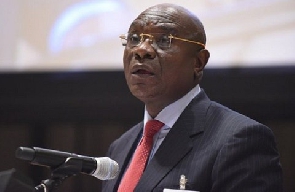The Bank of Ghana has maintained its policy rate for the first time this year. The Bank maintained its benchmark lending rate at 16 per cent.
The rate is usually indicative of the price commercial banks can borrow from the central bank.
Announcing the policy rate, the Governor of Bank of Ghana, Dr. Kofi Wampah said the increase was as a result of risk to government’s revenue , inflation and economic growth.
The governor also announced that for the half year government has spent about 4.5 per cent more than what it has brought in as revenue.
Below is the statement
1.Ladies and Gentlemen, you are welcome to the 56th Monetary Policy Committee (MPC) Press briefing. The Committee held its third meeting of the year during which the latest economic developments and risks to the outlook were discussed. We present to you highlights of these deliberations and the decision of the Committee on the monetary policy stance.
Global Economic Developments
2. The 2013 July update of the IMF’s World Economic Outlook revised global GDP growth downwards from 3.3 percent to 3.1 percent. This was on account of slackening growth in major emerging market economies, lower commodity prices, financial stability concerns, deeper recession in the Euro area and the slow growth in the US economy. However, growth was stronger than expected in Japan, driven by consumption and net exports.
3. Growth is expected to pick up slowly in advanced economies in 2013 at 1.2 percent. Emerging markets and other developing countries on the other hand are projected to grow at about 5 percent. In Sub-Saharan Africa, growth is forecast at 5.1 percent in 2013. The outlook suggests that much of the sub region could sustain a rapid expansion, on the back of rising foreign direct investment and relative macroeconomic stability.
4. The US Fed’s statement about the possibility of a slowdown in quantitative easing, led to some volatility in global financial markets during the period since the last MPC round, as this impacted on capital flows to emerging markets and yields on long term bonds.
5. Global inflation is also expected to remain subdued as cost pressures related to commodity prices continue to ease, while demand factors in high income countries remain weak. Inflation in emerging economies is expected to stay low, but significant upside risks remain in the outlook for high growth Sub Saharan African countries.
6. In the commodities markets, crude oil prices are expected to slow down during the second half of 2013, with forecasts ranging between US$100 and US$105 per barrel. Gold is projected to decline from US$1,525 to US$1,200 per fine ounce, while cocoa prices are expected to stay broadly stable at about US$2,470 per tonne.
7. These developments in the external environment continued to impact on the domestic economy, as declines in commodity prices affected external sector performance. The announced slow down in quantitative easing in the US also affected the yield on the new Ghana Eurobond.
Domestic Economic Developments
Inflation and Growth
8. Headline inflation (based on the old series) for June 2013 was 11.2 percent, up from 10.4 percent in March and 8.8 percent in January. The rise in inflation was largely due to petroleum price adjustments, demand pressures and seasonal factors. Food inflation was 6.4 percent in June 2013 from 5.5 percent in March 2013. Non-food inflation edged up to 14.0 percent from 13.2 percent in March 2013. The reconstituted CPI basket puts headline inflation at 11.4 percent for June 2013, compared to 10.6 percent in March.
9. The Bank’s Composite Index of Economic Activity (CIEA) indicated a marginal pickup during the second quarter of 2013. On a year-on-year basis, the index showed a growth of 3.4 percent compared to a 0.6 percent contraction in March 2013. Components of the CIEA that recorded positive yearly growth rates include, sales of key manufacturing entities, and DMBs credit to the private sector.
10. Surveys conducted by the Bank of Ghana in July indicated mixed sentiments by businesses and consumers. Consumer sentiments improved as indicated in their outlook for the economy as well as willingness to purchase household durables. The Consumer Confidence Index increased from 96.1 in April to 101.1 in June. Business sentiments however, softened with the index declining from 99.0 in March to 92.4 in June 2013.
Government Fiscal Operations
11. Preliminary data for the first half of the year indicate that, both revenue and expenditure were below their respective targets for the period. The budget recorded an overall deficit (cash basis) of 4.5 percent of GDP which was within target for the period.
12. Total revenue and grants was GH¢9.5 billion, against a target of GH¢10.6 billion. Of this outturn, domestic revenue amounted to GH¢9.0 billion, below the target of GH¢9.8 billion. Total tax revenue amounted to GH¢6.7 billion, compared to the target of GH¢7.7 billion. This was as a result of underperformance of almost all the tax types, reflecting lower imports and energy sector challenges. Grant disbursements amounted to GH¢507.6 million, 41.8 percent below target.
13. Non-tax revenues for the period amounted to GH¢2.2 billion, higher than the budgeted target of GH¢2.0 billion.
14. Total expenditures, including payments for the clearance of arrears and outstanding commitments for the first half of 2013 amounted to GH¢13.5 billion, compared to the target of GH¢14.6 billion. Employee Compensation for the half year amounted to GH¢4.7 billion, against a target of GH¢4.3 billion. Similarly, interest payments amounted to GH¢2.2 billion, against a target of GH¢1.6 billion.
15. The deficit of GH¢4.0 billion (4.5% of GDP) was financed mainly from domestic sources, resulting in a Net Domestic Financing (NDF) of GH¢3.0 billion, lower than the budget target of GH¢3.2 billion. Foreign financing of the budget amounted to GH¢1.0 billion.
16. The stock of public debt increased to GH¢39.1 billion (43.9% of GDP) as at the end of June 2013, from GH¢35.1 billion in December 2012. Out of the total public debt stock, the domestic component amounted to GH¢20.9 billion compared to GH¢18.5 billion in December 2012. External debt stock also stood at US$9.3 billion up from US$8.8 billion over the same period.
Monetary and Banking Sector Developments
17. The pace of expansion in monetary aggregates moderated in the first half of 2013. Broad money (M2+) grew by 14.2 percent in June 2013, compared with 34.2 percent in the same period last year. This was largely driven by a sharp drop in the annual growth of foreign currency deposits to 1.8 percent in June 2013 compared to 47.3 percent in the same period in 2012.
18. The latest Bank of Ghana survey of credit conditions showed a general net easing of credit conditions by DMBs. With the exception of consumer credit and long term credit to large enterprises, which saw some tightening, the credit stance for all other loan types including SMEs, large enterprises, short term and mortgage loans were eased during the period.
19. Annual growth in private sector credit slowed to 33.5 percent in nominal terms at the end of June 2013, from 39.0 percent in June 2012. Similarly, annual growth of real private sector credit was 20.1 percent in June 2013, down from 27.0 percent in June 2012.
20. The banking sector performed well during the first half of the year, with increased competition, asset growth, improved liquidity and profitability. Total assets of the banking industry as at the end of June 2013 increased to GH¢30.6 billion, compared with GH¢24.6 billion in June 2012. This was driven mainly by advances, which accounted for 44.7 percent of the total. The asset growth was mainly funded by deposits which recorded an annual growth of 13.3 percent to GH¢20.4 billion at the end of June 2013.
21. Non-Performing Loans (NPL) ratio within the banking industry decreased to 12.8 percent in June 2013, from 13.2 percent in June 2012. The ratio excluding the loss category also declined to 4.7 percent from 5.9 percent in the same period.
22. Interest rates broadly remained unchanged since the May meeting:
• The 91-day Treasury bill rate moved from 23.0 to 23.1 percent; and the 182-day bill remained unchanged at 23.0 percent. • The 1-year note rate declined from 22.1 percent to 22.0 percent; while the 2-year moved from 22.4 to 23.0 percent. • The 3-year bond rate rose from 16.9 percent in May to 19.2 percent in June. • There was no issue of the 5-year bond during the period.
23. The weighted average interbank rate inched up from 16.9 percent to 17.0 percent in June 2013.
24. The new Base Rate formula, which seeks to ensure transparency and uniformity in loan pricing in the banking industry, became operational during the period. Banks have fully complied with the new framework, with the industry average base rate declining by 3.0 percent.
25. Average lending rates of the banks rose to 27.4 percent in June 2013, from 27.1 percent in April 2013. The average rate on 3-month time deposits remained stable around 12.3 percent.
External Sector Developments
26. For the first half of the year, the trade deficit marginally improved to US$1.2 billion from US$1.3 billion in 2012 on account of a slow-down of both exports and imports. Merchandise exports were US$7.5 billion, declining by 0.8 percent in 2013; while imports declined by 2.6 percent to US$8.6 billion, reflecting in both oil and non-oil imports.
27. Export earnings from gold and cocoa beans were estimated at US$2.7 billion and US$1.2 billion respectively, compared to US$3.2 billion and US$1.6 billion in 2012 due to lower prices and volumes. Oil exports, however, increased by 47.7 percent in 2013 to US$2.0 billion as a result of increased production by the Jubilee Partners.
28. In the period January to June 2013, the Ghana cedi cumulatively depreciated at a slower rate of 3.4 percent against the US dollar, compared to a depreciation of 17.2 percent during the same period in 2012. In trade weighted terms, the Cedi appreciated in real terms by 1.8 percent compared to a depreciation of 14.3 percent last year.
29. Private inward transfers received through the banking system from January to June 2013, declined by 6.4 percent on a year-on-year basis to US$8.3 billion. Of the total transfers, US$928.4 million accrued to individuals compared with US$908.7 million in the same period of 2012.
30. Gross international reserves decreased by US$436.4 million to US$4.9 billion from a stock position of US$5.3 billion at the end of December 2012. This was sufficient to cover 2.7 months of imports.
Summary and Outlook
31. In summary, prospects for the global economy remained uncertain during the half year. Contributory factors include; the slackening growth in emerging market economies and the continued dip in commodity prices in international markets. The slow growth in the US economy also posed significant risks to the external outlook.
32. These developments in the external sector continued to weigh on the domestic economy, despite the improvement in the trade balance. The outturn was moderated by a slowdown in import demand.
33. Exchange rate pressures moderated during the half year relative to the same period last year, largely on account of the various policy measures implemented by the Bank. It is expected that the proceeds from the cocoa loan syndication and the Eurobond issue, amounting to a total of almost US$2.0 billion during the second half of the year, would shore up the international reserves and further calm pressures in the foreign exchange markets.
34. The fiscal outcome on cash basis was within the budget target for the half year. The Committee, however, noted with concern the lingering fiscal pressures arising from the huge wage bill and outstanding commitments.
35. However, the Committee also noted measures put in by Government to address the shortfall in revenues and also reduce expenditures. These include the re-introduction of the fiscal stabilisation levy, imposition of a levy on imports, and the environmental tax. Expenditure control measures include, refinancing of the domestic debt to reduce interest costs, regular adjustment of petroleum prices, rationalisation and standardization of allowances under the Single Spine Salary Scheme, and a moratorium on new projects. It is expected that there would be a gradual reduction in subsidies on utilities going forward.
36. Prospects for growth improved in the second quarter of the year as evidenced in the Bank’s Composite Index of Economic Activity (CIEA), a rebound in consumer confidence and improved credit conditions. In the outlook, the improvement in energy supply and increased oil production are expected to support growth.
37. The Committee however, took cognisance of potential risks to growth including the continued softening of commodity prices on the world markets, the ongoing fiscal consolidation as well as worsening business expectations.
38. In assessing the outlook for inflation, the Committee noted that the upside risks include; potential pass-through effects of further petroleum price adjustments, possible adjustment of utility tariffs, and pressures arising from the impending public sector wage settlement. These could however be moderated by the tight monetary policy stance, the ongoing fiscal consolidation and favourable seasonal factors arising from the oncoming harvest season.
39. The inflation forecast had shifted marginally since the last MPC meeting although the Committee noted that the forecast for end-year inflation is likely to be close to the upper band. However, subject to the rate and timing of the adjustment in utility tariffs, the forecast could return to central path by the first quarter of 2014.
40. In the circumstance, the Committee is of the view that the current monetary policy stance is appropriate and therefore decided to maintain the policy rate at 16 percent.
Business News of Wednesday, 31 July 2013
Source: Joy Online
BoG maintains policy rate citing threats to economic growth

















